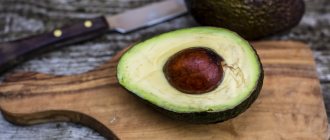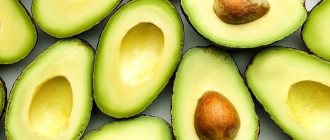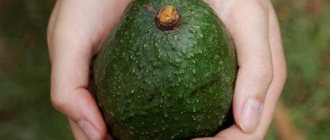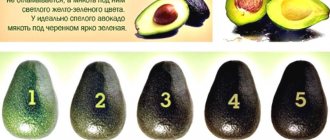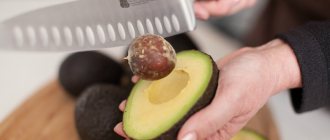Avocados are grown in areas with tropical and subtropical climates. After harvesting, the fruits do not immediately reach store shelves. During transportation, part of the harvest spoils, so owners often collect unripe fruits. Violation of storage or transportation conditions can lead to loss of taste and change in structure. Whether an avocado is black inside or not is a question that worries consumers who choose vegetables and fruits in supermarkets and retail outlets.
What are black spots inside an avocado?
The appearance of black dots inside is associated with technical ripeness. Ripeness is determined by several criteria:
- the mark from light pressure quickly disappears, the shell takes its previous shape;
- the area where the cutting was located becomes green, with brown spots;
- when pressing on the handle, the oil accumulated inside may seep out;
- when shaking inside, you can hear the tapping of the bone;
- The bone is easily separated from the pulp: it can be removed with a spoon.
The appearance of the peel will not say anything about the ripeness or safety of the pulp inside. Depending on the variety, the peel has green, brown and intermediate colors.
Whether an avocado can be eaten can be determined by the color and structure of the pulp. If the pulp is covered with black dots inside, this may indicate a violation of storage rules. The appearance of black spots occurs due to the fact that the fruit was first stored in a cold room, and then it gets into the heat.
The answer to the question whether it is possible to eat pulp with black dots inside also depends on how much blackness is spread over the surface. If the black spot is located far from the seed and the area covered by it is approximately 10% of the total, then such fruit can be removed by first removing the black spots with a spoon. Small black dots are picked out with the sharp tip of a knife, and then the pieces of pulp are used for their intended purpose. Such pieces will not taste bitter or have any other unpleasant taste.
If the black spot completely surrounds the pit on both halves, and when removed it turns out to be widespread at all levels within the pulp, then the fruit should not be eaten. In this case, there are several reasons for the appearance of black spots:
- sudden change in climatic conditions during storage;
- long stay at low temperatures;
- violation of transportation methods;
- possible stay in water and subsequent drying.
A black spot is evidence of overripeness. With maximum spread, it threatens the fruit with loss of taste and beneficial properties. It is better not to eat such fruit, since, most likely, it will taste bitter and, in addition, will lose its beneficial properties.
Is it edible if
The correct choice of ripe fruit is important so that it is suitable as a food component. You can buy unripe persea and store it at home for several days so that the fruit reaches the desired condition. A ripe avocado is dark green, almost black. You should not buy avocados that are suspiciously brown in color. If the fruit is damaged, with signs of spoilage, then the overseas exotic should be discarded.
Green
Fans of exotic novelties are interested in how to properly eat green avocados. You can eat unripe persea, but the flesh is coarse and tasteless, so eating it is a dubious pleasure.
With black dots inside
If the purchased avocado is intact on the outside and has all the signs of a healthy fruit, but contains black spots on the inside. It is undesirable to eat such exotic food. You can remove the dark spots and eat the yellow pulp, but its taste will not match the fresh overseas fruit.
The pulp has darkened
Buyers are interested in whether it is possible to eat an avocado if its flesh has darkened. You can eat it, but the real taste of fresh fruit is lost, so the quality of the dishes will differ from what was intended. Dark flesh indicates that the fruit was stored in unsuitable conditions or was exposed to sudden temperature changes.
The benefits and harms of avocados for the body
Dark green fruits with a rough skin and a pit inside contain fiber, potassium, vitamins B, K, E, C (one fruit contains 50% of the norm), as well as folic acid (it reduces the risk of congenital anomalies in the unborn child).
The pulp of a ripe avocado has a delicate, oily consistency with a high content of vegetable fats and tastes like a walnut.
In terms of nutrients and minerals, avocados can be compared to pharmacy multivitamins.
This rich chemical composition of avocado lowers cholesterol levels in the blood, strengthens the immune system and bones, helps lose weight, normalizes blood circulation, and increases performance.
In the summer, one of the most popular and healthy drinks is an avocado smoothie with almond milk. Photo: Restaurant Christian
However, the overseas fruit is not only useful, but also has contraindications. Who shouldn't eat avocado?
- Firstly, for allergy sufferers. Especially those who have a strong reaction to citrus fruits. Experts recommend that such people either first take a test for tolerance to the fruit, or include it in the diet gradually, observing the body.
- Secondly, people suffering from gastrointestinal diseases should refrain from eating avocados. In this case, it is also recommended to consult your doctor. Avocados are high in fat, which can negatively affect the digestive system.
- Thirdly, diabetics should treat avocados with caution - 100 grams of this product contains approximately 8.5 grams of carbohydrates.
You can prepare a large number of delicious dishes from avocados, but before eating this overseas fruit, you first need to find out if you are allergic to it. Photo: Restaurant “Syrovarnya”
Chemical composition
Avocado is the most nutritious fruit of all plant foods, with the exception of coconut. The calorie content of 1 piece of ripe fruit is 250 calories. Therefore, it is recommended to eat no more than 1/5 of an alligator pear at a time. Calorie content per 100 grams – 167 calories.
The energy ratio B: F: U is 5%: 82%: 5%.
This product is unique in composition; it contains essential unsaturated fatty acids, many vitamins, minerals, fiber, antioxidants (lutein), beta-sitosterol, which are beneficial for the human body and beauty.
Nutritional value of avocado pulp per 100 grams:
- proteins – 2 grams;
- carbohydrates – 6 grams, of which 5.3 grams are fiber, 0.7 grams are monosaccharides;
- fats – 15 grams, of which 2.4 grams are saturated lipids, 10.3 grams are monounsaturated, 2.3 grams are polyunsaturated;
- water – 73 grams.
Delicious recipe! Air Fryer Recipes
Table No. 1 “Chemical composition of avocados”
| Name | Nutrient content in 100 grams of avocado, milligrams |
| Vitamins | |
| Retinol (A) | 0,03 |
| Thiamine (B1) | 0,06 |
| Riboflavin (B2) | 0,04 |
| Niacin (B3) | 0,6 |
| Pantothenic acid (B5) | 1,0 |
| Pyridoxine (B6) | 0,2 |
| Folic acid (B9) | 0,0185 |
| Ascorbic acid (C) | 7,7 |
| Phylloquinone (K) | 0,019 |
| Macronutrients | |
| Potassium | 280 |
| Phosphorus | 33 |
| Calcium | 15 |
| Sulfur | 15 |
| Chlorine | 11 |
| Magnesium | 10 |
| Sodium | 2 |
| Microelements | |
| Iron | 1,0 |
| Aluminum | 0,8 |
| Zinc | 0,29 |
| Copper | 0,25 |
| Manganese | 0,21 |
| Bor | 0,1 |
| Fluorine | 0,014 |
| Molybdenum | 0,01 |
| Iodine | 0,002 |
| Cobalt | 0,001 |
Avocado is a natural source of unsaturated fatty acids that are easily absorbed by the human body. Interestingly, the tropical fruit has twice the calorie content of beef, and the amount of vitamin F (omega-3.6) is three times higher than fish oil. In addition, avocado pulp contains five times more tocopherol than olive oil. It’s not for nothing that the Indians of South America call the fruit “forest oil.”
How to eat it raw?
The avocado is cut lengthwise around the pit; the skin is not peeled. After dividing the fruit into two hemispheres, take out the seed by prying it with the tip of a teaspoon. The part of the fruit planned for consumption is peeled.
Overly soft with bruised skin
When checking for ripeness, use the palm of your hand to gently squeeze the avocado. Do not press the fruit with your fingers as this may damage the flesh.
If the avocado is very hard and cannot be pressed at all, it means it is unripe. If it gives a little, it's probably ripe and ready to eat.
However, if squeezing leaves small indentations, the fruit may be too ripe to cut and would benefit from being pureed.
The fruit is overripe and probably spoiled, perhaps if pressure leaves large dents and the fruit becomes soft.
Also, if the avocado already has dents before you squeeze it, it's probably already started to go bad (2).
Summary:
If you gently squeeze an avocado in the palm of your hand and it forms large indentations where you pressed, the fruit is overripe and likely spoiled.
Dark, striped flesh
Once you cut an avocado, it's much easier to tell if it's gone bad. Of course, this option is only suitable if you have already bought the fruit.
Avocados that are ready to eat have light green flesh. Rotten pulp has brown or black spots (2).
However, an isolated brown spot may be due to dents rather than widespread deterioration and can be cut off.
Another possible sign of rotting is dark streaks in the flesh.
However, some avocados, especially those picked from young trees, may have dark streaks even if they are not rotten. If the fruit looks good and does not taste bad, it is safe to eat.
Likewise, the texture of an avocado can be uneven when it's spoiled. However, if there are no other signs of rot, this is not necessarily a bad thing. The fibrous texture can also be attributed to growing conditions (2).
Summary:
Spoiled avocado flesh has dark spots and a streaky texture that tastes bad. However, isolated areas of discoloration may be associated with dents.
Avocado
The beginning of the 1980s gave birth to a significant movement - the anti-fat campaign. The United States Department of Agriculture (USDA) issued dietary guidelines, and health institutes urged Americans to reduce their cholesterol intake. That same year, the government spent $150 million on a study that showed that eating fat increases the risk of heart attack. In his article for Time, Brian Welsh writes that scientists were wrong when they declared fat as enemy number one.
But the biggest example of extreme marketing is the avocado story.
Photo Getty Images / Photo Getty Images
The story of how the avocado went from being a little-known alligator pear on the West Coast to becoming a top-selling fruit stems from years of work by the Hill & Knowlton PR team to put avocados on menus around the world, increase sales, and spread the product across the planet. There were many problems along the way: manufacturers could not imagine how to sell a product with the unappetizing name “alligator pear,” how to get people to eat the unsweetened fruit with a slippery texture, and what and when to eat it with.
Issues were resolved as they were received. They decided to rename the alligator pear into something simpler - avocado. At the same time, nutritionists emerged obsessed with the idea of including large amounts of the “right” fats in the diet. New trends have appeared in the world of proper nutrition: keto and paleo diets, pegan (a hybrid between paleo and vegan). The keto diet involves a low-carbohydrate diet with an advantage of fats and a moderate amount of protein in the diet. Healthy fats have never been more in demand than they are now.
It is obvious that all the efforts of the campaign organizers were not in vain.
Avocado recently took the top spot in America's fruit baskets. In the 1990s, the average American ate about 5 pounds of the fruit, and in 2012, avocado sales increased fivefold. For comparison: during the same period, the consumption of fresh apples decreased by 0.2 kg. How did it happen? Watch the cartoon "Teen Titans Go!"
Fans of healthy eating began to open cafes and restaurants dedicated to avocados; souvenirs, clothing and interior items depicting a green fruit with a brown “belly” are actively produced and sold. Instagram is full of photos of a breakfast that many people love: toast with avocado, salmon and a poached egg. The food trend has already appeared in recipes for all dishes: from drinks to desserts.
Avocados have a well-founded image as the healthiest product. It has a lot of vitamins, fiber, no sugar at all and a lot of “good” fat. However, not everything is as clear as it might seem. Not all yogurts—oops, sorry—fat are created equal. "Consuming too much of the fruit can lead to excess weight due to the fat content in avocados, even though it is unsaturated," San Diego-based nutritionist Lara Flores told LiveScience. The authors of the Stylecraze portal claim that consumption of this fruit may be unsafe for young mothers. And people with so-called latent allergies should generally stay away from the green fruit, as the Mayo Clinic calls for.
In the summer of 2022, publications appeared online about how a number of cafes and restaurants were abandoning avocados. The Independent interviewed two English restaurant owners, Wild Strawberry Cafe and Tincan Coffee Co. You can no longer have avocado toast for breakfast in these places - their owners believe that transporting avocados from other continents causes a large ecological footprint on the planet. Avocado planting involves cutting down forests and using large amounts of chemicals, and the fast-growing business attracts unscrupulous investments. Mexican Greenpeace saw a problem with avocados back in 2016: “Transporting the fruit to other countries requires large volumes of agricultural chemicals and wood. These factors can affect the environment and human well-being.” In May of this year, the manager of the Richter restaurant, Evgeniy Shchur, and I discussed the supply of vegan ice cream for the largest club “Mutabor” (Arma17, Outline), the condition of their management is the following: no avocado in the composition - this is detrimental to the health of the planet.
Photo DR / Photo DR
However, avocados continue to gain popularity. For example, Arkady Novikov’s Avocado Queen restaurant opened in Moscow in a location as fashionable as the fruit itself - Patriarch’s Ponds. It's always full there. At the time of writing, another project - Avocado Point - “the first avocado bar” - launched three points in Moscow and one in St. Petersburg. And in February of this year, streetwear giant Saucony released a pair of “avocado toast” sneakers. .
Is it possible to eat a darkened avocado?
Avocado has long been considered an exotic fruit, but recently its presence on supermarket shelves has become commonplace. Despite this, consumers are not fully familiar with the characteristics of this culture. Many people are frightened by the ability of the fruit to darken after cutting. In fact, there is nothing wrong with this. The fact is that the pulp contains an increased amount of iron inside. Upon contact with air, an oxidation reaction begins. This causes the cut halves to darken.
How to eat avocado correctly
Is it possible to eat avocados every day? This is what Internet users are most often interested in. We asked nutritionist Irina Korkunova this question, and this is what she said.
“Avocado every day? Why not? It is a good source of healthy saturated fats and polyunsaturated fatty acids. And if you meet your daily requirement, then please eat it at least every day. But if you want to lose weight, then remember: avocado is a very high-calorie fruit that does not burn fat. With it, as with any other product, you need to be careful not to overeat. The calorie content of one fruit is approximately 250-300 kcal. Can you imagine? But I repeat once again, avocado is very beneficial for the body and should be included in the diet. Just in moderation."
Everyone chooses their own way of eating avocados - every day or once a week, raw or after heat treatment. In the first version, the fruit is cut into two halves, the pit is removed, a piece of butter is placed in the hole, sprinkled with salt for a brighter taste, and all this is consumed with a teaspoon.
Anyone who does not like the oily taste of raw avocado uses it as a side dish for meat and fish dishes, in salads, sauces, cream soups, and snacks. The neutral taste of avocado goes well with ham, turkey or chicken, hare or game.
Avocados are easy to peel even with a regular tablespoon. Photo: pixabay.com
LEMON on the farm
Cleaning the microwave oven. Are there burnt food residues visible inside your microwave? All this can be completely cleaned with lemons, without resorting to chemicals or spending a lot of effort. Simply stir 3 tablespoons of lemon juice into 1.5 cups of water in a microwave-safe bowl. Heat for 5-10 minutes on high - steam will condense on the interior surfaces of the oven. All you have to do is wipe off the softened food residue with a rag.
Cleaning the cat litter. There's no need to spray with aerosol freshener to eliminate foul cat litter odors or musty bathrooms. All you have to do is cut a couple of lemons in half. Place them cut side up on a plate and soon the room will be filled with a fresh lemon aroma.
HOMEMADE BATTERY. Turn a lemon into an electric battery. Of course, it won’t move the car, but it will give you the opportunity to taste the electric current. Roll the lemon on a flat surface to activate the juice, then make two small cuts in the lemon, 1/2 inch apart. Insert a coin of 10 kopecks into one cut, and 1 ruble into the other. Then touch both coins with your tongue at the same time. You will feel a slight tingling sensation. Here's how it's explained. Lemon acid reacts differently with each of the two metals. One coin is charged positively, the other negatively. The difference in charges causes an electric current. The tongue conducts electrical current and senses it.
Shine on dull aluminum. To make dull pots sparkle inside and out, just rub them with the cut of half a lemon and polish them with a soft cloth.
To prevent the rice from sticking together. To prevent the rice from becoming a sticky mass, add a spoonful of lemon juice to boiling water. Once the rice is cooked, let it cool for a few minutes and fluff it with a fork before serving.
Removing ants from the kitchen. You don't have to use insecticides or ant traps to rid your kitchen of insects. Treat the room with lemon. First, squeeze lemon juice onto the threshold and window sills, then pour it into all the cracks and holes. Lemon is also effective against cockroaches and fleas. Mix the juice of 4 lemons (along with zest) and 2 liters. water and wash the floor with the solution - the fleas and cockroaches will go away. They can't stand the smell of lemon.
Cutting boards: eliminating odors. No wonder the cutting board smells! After all, you cut onions on it, chop garlic, cut raw and cooked meat, and cut up fish. To get rid of odors and disinfect the board, rub it with the cut of half a lemon or rinse it with undiluted lemon juice.
How to clean the faucet from plaque? To remove limescale from a chrome faucet, rub it with half a lemon. Rinse, dry and polish.
Wipe down your microwave after use. If the smell persists, place a bowl of water and drops of lemon juice in the chamber, hold it on high heat for 1 minute, and wipe the chamber.
Removing warts. You've tried every imaginable remedy, but the warts won't give up. Here's another recipe: Use a cotton swab to apply some lemon juice directly to the wart. Repeat the procedure for several days until the citric acid removes the wart completely.
We recommend reading: Freezing Fried Minced Meat
Kindling. Dried orange or lemon zest makes much better kindling than newspaper. Not only do they smell nice and produce less creosote than newspapers, but they also burn longer thanks to the flammable essential oils they contain.
Scented balls. Scented beads have been used for centuries to fill tight spaces with a pleasant scent and keep moths away. They are very easy to make yourself. Take a handful of whole cloves and stick them into the entire surface of the lemon or orange peel. That's all. Now hang your scent ball on string or fishing line in your closet, closet or kitchen cabinet for a fresh scent for years to come.
Invisible ink. Children love to send and receive secret messages, but what's the best way to do this? With invisible ink, of course. All you need for this is lemon juice as ink, a cotton swab instead of a pen and a sheet of white paper. When the ink is dry, children should hold the paper in bright sunlight or under a lamp to read what has been written. The heat will darken the written lines to a light brown color, and the letter will be readable.
HELPFUL TIP (before squeezing the lemon juice): To get the most lemon juice, bring the lemons to room temperature and roll the palm of your hand on the table. This will break down the connective tissue and cell membranes of the fruit, causing it to extract more juice when squeezed.
Plant milk
Plant milk has emerged as an excellent alternative and replacement for traditional milk for people with lactose intolerance, allergies and other medical contraindications. It’s hard to believe now, but in 2008, the only alternative milks available were soy and rice, and they weren’t so easy to find.
“They were dead shelves back then,” recalls John Schoolcraft, Oatly’s global creative director. “Only for people who are lactose intolerant or allergic to milk, vegans and vegetarians—people who were on the margins at the time.”
The boom in alternative milk, like any other healthy product, is associated with the hype around a healthy lifestyle and the trend for clean eating. Cow's milk's reputation as a healthy product is under threat. Food fanatics cited the increased risk of developing cancer, allergies, and excess weight as arguments. When removing cow's milk from the basket, it was necessary to offer a replacement, and then consumers remembered about alternative milk. In addition, plant-based milk has begun to gain popularity thanks to Instagram celebrities calling for the elimination of everything processed, allergenic and unnatural from the diet. Alternative milk captivates with its variety - almonds, walnuts, pine nuts, hazelnuts, peanuts, cashews - and these are just the nut options. But there is also coconut, hemp, sesame, pumpkin, soy, oat, rice and quinoa milk.
Photo by Drew Angerer/Getty Images/Photo by Drew Angerer/Getty Images
Meanwhile, declining demand for cow's milk and falling prices led to the closure of thousands of dairy farms in the UK between 2013 and 2016.
At the same time, sales of plant-based milks grew by 30% in the UK, and in the US, almost half of consumers are adding alternative milks to their cart. Its global production is now estimated at $16 billion.
Oatly is a Swedish plant-based milk company that carved out a niche in the market in 2016. To its surprise, it quickly went from being a little-known health food brand to becoming the most popular alternative to cow's milk. Since 2016, the company has increased production by 1,250% to keep up with demand for its products.
"It's actually a water-based emulsion where you add butter, a lot of sugar and chewing gum, and then just a couple of nuts on top ," said Cheryl Mitchell of Elmhurst. “As a business model, it’s great—you can sell water any time, right?”
There are also undesirable consequences from drinking plant-based milk. Most often they are associated with allergic reactions to the very substrate from which it is made. In addition, natural soy milk contains high levels of phytic acid, which interferes with the absorption of other vitamins and minerals when consumed simultaneously with other foods. Coconut milk contains significantly less calcium than soy and cow's milk. May contain carrageenan, which may cause digestive problems in some people. Almond milk is a poor source of protein, and rice milk is not recommended for people with diabetes due to its high carbohydrate content. The glycemic index of rice milk varies from 70-90 depending on the manufacturer.
Why is avocado bitter?
Often, after successfully choosing a fruit, it turns out that it tastes bitter when consumed. If, in addition to bitterness, the avocado contains brown streaks inside, this means that the fruit is completely overripe. There will be no benefit from its use, and you should not eat it. In addition, the taste of dishes prepared with it will suffer.
The second reason for the appearance of bitterness may be the unripeness of the avocado: in this case, it will be light yellow inside, with a bitter taste.
The pulp also begins to taste bitter after heat treatment. Usually people start eating it raw, so as not to expose it to high temperatures, which destroy the structure and contribute to the loss of beneficial properties.
Summarize
- An avocado is spoiled if it is soft when squeezed, brown or moldy inside, and it tastes rancid or smells sour.
- You can salvage some of the fruit if it is just starting to brown inside, but the rest of the fruit looks and smells and tastes great.
- Inspect your avocado carefully in the store and keep a close eye on it at home to avoid having to throw it away.
The article was prepared by experts for informational purposes only. It should not be used as a guide for treating medical conditions and is not a substitute for professional medical advice, diagnosis, or treatment. In case of illness or any symptoms, you should always consult a doctor and not self-medicate.
Tags: Avocado
About the author: Alexander Fedorov
Candidate of Biological Sciences, biologist, nutrition expert. Graduated from Stavropol State University with a degree in Biology at the Faculty of Biology and Chemistry.
- Related Posts
- Kiwi: benefits and harm to the body, how much to eat
- Raspberries: beneficial properties and contraindications
- Grapefruit: benefits and harm for the human body
« Previous entry
By taste or smell
Ripe avocados have a pleasant, slightly sweet aroma and a slightly nutty taste. As the fruit spoils, its taste and smell may deteriorate.
If it tastes or smells sour, it may have bacterial spoilage and should be discarded (2).
A chemical smell and taste may mean it is rancid. This can happen when oxygen or microbes damage or break down the unsaturated fat in the fetus (4).
Rancidity can lead to the formation of potentially toxic compounds. Don't eat an avocado if you think it's rancid (5).
The taste of spoiled avocados can vary, but it's usually easy to tell if they've gone bad based on the taste.
You can tell if an avocado has gone bad by smell, taste, touch, and visual inspection.
Summary:
A sour taste or smell, as well as a rancid aroma and chemical taste mean the avocado is spoiled and you should discard it.
How to choose an avocado
Ripe avocado:
- when pressed, a small dent formed;
- the flesh is bright green;
- When you shake the fruit, you can hear the sound of the stone.
Unripe avocado:
- when pressed, a large dent formed or did not form at all;
- hard fruit;
- yellowish flesh;
- When shaking the fruit, the sound of the stone is not heard.
Leave a comment (0)
Mold
Mold on avocados is usually white or gray and has a fuzzy appearance. Do not inhale it, as you may inhale mold spores and cause breathing problems if you are allergic to it.
Avoid buying avocados with mold on the outside, as it can penetrate into the flesh and cause the entire fruit to spoil.
If you cut an avocado and see mold, discard the entire fruit. Although you may only see mold in one area, it can easily spread through the pulp. Do not try to save the fetus (6).
Summary:
Mold is a clear sign that the avocado has gone bad. You should discard the entire fruit as mold may spread through the flesh but may not be completely visible.
Cling film
Food (polyethylene) film is also an indispensable tool for preserving the freshness of various food products and already prepared dishes. And avocado in this case will be no exception.
To do this, you just need to wrap the remaining piece of fruit in film and put it in the refrigerator. And if you notice that the avocado is still darkening (after a day or two), then it will be enough to simply remove the top weathered layer and you will again see the attractive green color of freshness.
If you hate throwing away the rest of the avocado and have nowhere to put it (everything is already cooked), then a great way to keep the fruit fresh is to make the famous and incredibly tasty guacamole from it. To do this, you just need to mash the avocado and add 1 tablespoon of lime (per half) to the resulting paste.
A tart lime juice (like lemon juice) will prevent the avocado from oxidizing and maintain its attractive green color. But to be sure, place your guacamole in an airtight container (you can also cover it with cling film first).
Thus, the film and lid will prevent the avocado from being exposed to oxygen, and hence its chapping and oxidation. Later you can use this avocado paste by adding it to a salad or just as is, it will also be very tasty.
Avocado fruits are a valuable source of protein for those following a vegetarian diet.
Some nutritionists even believe that avocado fruits can replace all other food for a person, and he can exist by eating only avocados and water. However, not every person knows how to eat avocado and what can be prepared from it.
How to peel an avocado?
To peel an avocado, you need to make a cut along the entire diameter with a sharp knife until the knife rests on the pit. Separate the two halves by twisting slightly (one clockwise and the other counterclockwise) - if the fruit is ripe, this should be very easy. Carefully walk the knife around the bone and remove it. Then you need to take half of the avocado and make another shallow cut in the skin from top to bottom. Gently pull the tip of the peel; it should peel off easily.
How to eat avocado?
The avocado fruit is eaten raw. Only the pulp of the fruit is consumed; the peel and pit are poisonous; they contain substances that can cause a dangerous allergic shock in humans.
It is easier and more convenient to eat it directly from the peel, using a spoon, sprinkling the fruit with lemon juice and seasoning with pepper and salt. When cooked, this fruit acquires a bitter taste and becomes unpalatable. You can make sandwiches from the avocado fruit, combining it with a slice of bread and a layer of fish, meat or crab sticks, and adding it to salads.
How to choose a good avocado?
To experience all the beauty of the described fruit, you need not only to know how to eat an avocado, but also how to choose it correctly.
Choose ripe fruits that are firm but not too hard. Press the peel with your finger; there should be an indentation. If the fruit is not ripe, it has a very unpleasant bitter-tart taste. Set aside those whose skin has any damage or defects and ignore the color. It can be different, because there are more than four hundred varieties of avocados in the world.
If you bought an unripe fruit, you can put it aside for a few days and it will “ripen.” The optimal temperature for long-term storage of avocados is ten degrees Celsius.
Growing an avocado from the seed?
Each fruit contains a large seed. It is not suitable for food, because... It is poisonous, but if desired, you can germinate it and plant it in the ground. If everything goes well, you will have an interesting indoor plant with a small number of leaves at the top, which, however, is very sensitive to dry air and replanting. Now plant the avocado pit with the blunt end in the ground and the sharp end should remain level with the soil. Before the leaves appear, grow the avocado at 18°C, and then transfer to a cool place.
Product overview
- Moisturizing balm for dry and very dry skin Ultra Facial Deep Moisture Balm, Kiehl's
The rich texture provides high-quality hydration, helps reduce irritation, and has a calming effect. Strengthens the barrier function of the skin. - Creamy Eye Treatment with Avocado, Kiehl's
Instantly moisturizes. The comfortable consistency does not overload the thin skin of the eyelids and does not leave a sticky or greasy film.
- Ultra Facial Overnight Hydrating Masque, Kiehl's
Gives the skin a generous supply of moisture and helps retain it for a long time. Apply in the evening: first apply a thick layer for 10 minutes, then remove excess with a cotton pad and leave the mask on until the morning.
